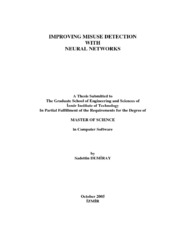Please use this identifier to cite or link to this item:
https://hdl.handle.net/11147/3284Full metadata record
| DC Field | Value | Language |
|---|---|---|
| dc.contributor.advisor | Tuğlular, Tuğkan | - |
| dc.contributor.author | Demiray, Sadettin | - |
| dc.date.accessioned | 2014-07-22T13:51:14Z | - |
| dc.date.available | 2014-07-22T13:51:14Z | - |
| dc.date.issued | 2005 | - |
| dc.identifier.uri | http://hdl.handle.net/11147/3284 | - |
| dc.description | Thesis (Master)--Izmir Institute of Technology, Computer Engineering, Izmir, 2005 | en_US |
| dc.description | Includes bibliographical references (leaves: 68-69) | en_US |
| dc.description | Text in English Abstract: Turkish and English | en_US |
| dc.description | xi, 92 leaves | en_US |
| dc.description.abstract | Misuse Intrusion Detection Systems are rule-based systems that search attack patterns in the data source. Detection ability of misuse detectors is limited to known attack patterns; hence unknown attacks may be missed. In addition, writing new signatures for novel attacks can be troublesome and time consuming. Similarly behavior based IDSs suffered from high rates of false alarms. Artificial neural networks have generalization ability, thus they can be used with intrusion detection system in order to identify normal and attack packets without the need of writing rules. We proposed to use neural networks with network-based IDS. To achieve this, system was trained and tested with both normal and malicious network packets. Backpropagation and Levenberg-Marquardt algorithms were used to train neural networks. For each of these training algorithms a 3-layer and a 4-layer MLP network sets were generated. In addition, self-organizing maps were used to classify attack instances. DARPA 1999 Intrusion Detection Evaluation dataset was used for training and testing, but lack of enough attack patterns in evaluation dataset made us to create a testbed to obtain sufficient malicious traffic. After training was completed, trained neural networks were tested against training dataset and test dataset, which is not part of the training dataset. Results of the experiments showed that, none of the trained backpropagation networks could identify attacks in training and/or testing data sets. But results of the Levenberg-Marquardt networks were more promising as nine of the trained Levenberg-Marquardt networks could identify attack and normal network packets in training and test datasets. | en_US |
| dc.language.iso | en | en_US |
| dc.publisher | Izmir Institute of Technology | en_US |
| dc.rights | info:eu-repo/semantics/openAccess | en_US |
| dc.subject | Neural network | en_US |
| dc.subject | Back propagation networks | en_US |
| dc.subject.lcc | TK5105.59 .D36 2005 | en |
| dc.subject.lcsh | Computer networks--Security measures | en |
| dc.title | Improving Misuse Detection With Neural Networks | en_US |
| dc.type | Master Thesis | en_US |
| dc.institutionauthor | Demiray, Sadettin | - |
| dc.department | Thesis (Master)--İzmir Institute of Technology, Computer Engineering | en_US |
| dc.relation.publicationcategory | Tez | en_US |
| dc.identifier.wosquality | N/A | - |
| dc.identifier.scopusquality | N/A | - |
| item.languageiso639-1 | en | - |
| item.grantfulltext | open | - |
| item.fulltext | With Fulltext | - |
| item.openairecristype | http://purl.org/coar/resource_type/c_18cf | - |
| item.openairetype | Master Thesis | - |
| item.cerifentitytype | Publications | - |
| Appears in Collections: | Master Degree / Yüksek Lisans Tezleri | |
Files in This Item:
| File | Description | Size | Format | |
|---|---|---|---|---|
| T000408.pdf | MasterThesis | 2.41 MB | Adobe PDF |  View/Open |
CORE Recommender
Page view(s)
250
checked on Jun 10, 2025
Download(s)
82
checked on Jun 10, 2025
Google ScholarTM
Check
Items in GCRIS Repository are protected by copyright, with all rights reserved, unless otherwise indicated.